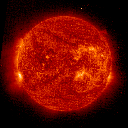Didn't hurt a bit
 Back in 1825, when 16-year-old Charles Darwin was studying to enter Cambridge University, before even your almanackist was born, a monsieur named Anselme Gaëtan Desmarest was the first to describe a particular crab, Ocypode cordimana, or the Ghost crab -- a bloke we looked at in a recent post. In fact, Monsieur D described a lot of crabs in a life devoted to science (like that of his old man, the geologist Nicolas Desmarest).
Back in 1825, when 16-year-old Charles Darwin was studying to enter Cambridge University, before even your almanackist was born, a monsieur named Anselme Gaëtan Desmarest was the first to describe a particular crab, Ocypode cordimana, or the Ghost crab -- a bloke we looked at in a recent post. In fact, Monsieur D described a lot of crabs in a life devoted to science (like that of his old man, the geologist Nicolas Desmarest).Allow me, too, to describe Ocypode cordimana: Owch! My son Remy is staying with me this week, and I, like most men, am about 100 times more likely to do silly things such as chasing a Ghost crab to catch it and show how harmless it is, when accompanied by a younger person (Remy became a teenager on January 25). There really is something very unbecoming about grown men chasing crabs on beaches alone.
Remy and I have been discussing Darwinian Natural Selection of late, and today's Ocypode was an excellent case in point. Be it known that Ghost crabs have more than one adaptation for fitness in this environment and thus for survival as a species. For one, they have a canniness that exceeds that of the average almanackist.
Rem and I had been exploring this beach and the one south, all the while observing a great many wondrous things, including holes and mullock heaps left by historical gold miners, and holes and mullock heaps left by contemporary Ghost crabs.
One of the best Ocypodal adaptations for survival is its ability to spend most of the day and night underground, mostly above the intertidal zone, near the edge of the beach and the vegetation. There in their burrows, the entrances of which might be as big as something you could stop with a tennis ball, or more often a golf ball, they sit the time out in between their diurnal and nocturnal carnivorous and cannibalistic forays. They are known to eat a wide variety of dead critters (four-wheel drive vehicle drivers not included, more's the pity).
I can't tell you what they do down there, because I've never dug one up (perhaps M. Desmarest did). But I can say with some certainty that such a subterranean existence is one helluvan adaptation for survival, especially when combined with a set of six extremely fast legs (not counting two effective nippers). On the rare occasions that you get close enough to see a Ghostie running for cover, you'll be amazed at his speed. Any bird that hopes for a feed of crab has his work cut out for him, cause these guys can really sprint.
Which brings me back to today's Ghostie, the one I had intended to serve as a parental example of bravery over timidity when it comes to encountering things that creep, crawl, slither, fly and sprint over the surface of our planet. Their planet.
It was Rem with his good eyes who spotted him first, a glorious specimen about the size of a matchbox. The Ghost crabs are named for their translucent bodies, and they are well camouflaged against the sand. Darwinian Survival Adaptation Number Four.
Monsieur crab spotted us too, and made a dash for his hole ... maybe for any hole. A month or so ago I saw two much smaller specimens, probably in courtship, scatter when they felt my footsteps approach, and they took shelter under separate pebbles. As I got closer, they left their temporary hideouts at breakneck speed, both of them diving down the same hole. I wonder to this day if it was their place or a startled neighbour's. Anyway, today's crab was fast but he couldn't outrun me, and probably knew it, so he stopped running all over the place on the sand, and headed for a place he knew he would have the advantage over a big landlubber like me (or a bird). He made a dash for the Pacific Ocean. Survival Adaptation Number Five.
And Number Six: there in the shallows, he burrowed into the sand for a few centimetres as we followed in what the classics call 'hot pursuit'.
While Remy kept his eye on where Monsieur Ocypode had self-interred, I stepped back from the incoming tide to empty both my hands of a whole bunch of plastic junk I'd picked up on our long walk to Emerald Beach. Then, with the bravery and certainty born of long experience at catching ferocious Australian carnivores, I dug with my bare hands (yes, unprotected!) into the sand beneath the water and proudly brought up the frightening beast. Steve Irwin eat your affected accent out!
Quick as lightning, well before I could get out, to filial admiration, the proud words, "See, son, they can't hurt you", this one gave me a nip that drew immediate blood. Darwinian Survival Adaptation Number Seven. These adaptations help to explain why this species of crab can be found in places as diverse as the Red Sea, Somalia, Madagascar, and South Africa as well as Japan, Tahiti ... and Sandy Beach. Possibly an ability to catch planes is another.
I'm still working out what it is, but I'm sure there must be a lesson in all this apart from something about the mechanisms of evolution and "Fathers are big kids still growing up".



















0 Comments:
Post a Comment
<< Home